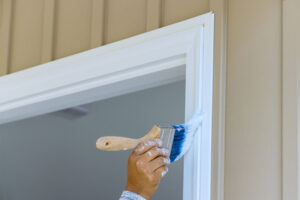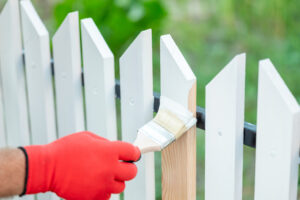
Best Paint for Trim and Baseboards
Baseboards and trim can elevate the appearance of your home’s interior, but even the most ornate trim piece will look dilapidated if it is not
With record-breaking heat waves hitting many parts of the country, everything from the travel industry to construction is being affected. One aspect of construction and home improvement that is especially susceptible to the heat is painting, as the ambient and surface temperatures can significantly impact the final results. With this guide you’ll learn how high heat affects paint as well as how to paint in extreme temperatures.

Paint is made of a color pigment suspended in a solvent or binder. There are two main classes of paints, oil-based and water-based, and high temperatures have a slightly different effect on each type of paint.
Oil-based paints are predominantly made from linseed oil with suspended pigment. Instead of evaporation, these paints dry through a chemical process known as oxidation – which causes them to dry more slowly than other paints. It can take anywhere from 8-24 hours for a layer of oil paint to dry under normal conditions. Warmer temperatures can actually speed up the drying time in a helpful way because it accelerates the oxidation reactions that lead to drying. Temperatures over 90 degrees fahrenheit, however, can damage your paint and project. When oil-based paint is exposed to extreme heat, the surface layer of the paint oxidizes and dries more quickly than the paint against the surface. This can cause the paint to dry with an irregular surface or color at best, or to peel or crack at worst. With the high-gloss finish of oil paints, any imperfection will be especially magnified.
In comparison, water-based paints are made with pigment suspended in acrylic polymers with or without latex polymers. These paints normally dry by evaporation, which is a much faster process than oxidization. It usually takes 2-4 hours for a water-based paint layer to dry. The paints will also dry slightly faster in warmer temperatures than cooler ones, but they start to run into issues at temperatures higher than 85 degrees Fahrenheit. When water-based paint is exposed to extreme heat, evaporation occurs too quickly and the polymers that bind the pigment become disrupted. This can cause all manner of unsightly blemishes from wrinkles and cracks to bubbles and blisters.

Now that you know how high heat affects paint, you may be wondering how you can avoid those detrimental effects – especially if you’re living somewhere where the temperatures are consistently above ideal threshold. Here are the following steps and measures you can take to beat the heat and get the most out of your painting project:
As a general rule-of-thumb, you want to aim for at least two consecutive days of good weather when planning your paint job. This means two of the relatively cooler days and no rain forecasted. Wind and humidity can also impair your painting, so make sure you’re paying attention to all aspects of the forecast. If getting better weather for your project means waiting an extra weekend or two (or six), it will absolutely be worth it.
The air temperature isn’t your only enemy when trying to complete a summer painting project – the sun can ultimately cause you more problems than anything. This is because as the sun beats down on a wall it can increase the surface temperature by 20 degrees compared to the outside air temperature – and it can rise even more if you’re painting a surface like metal. You may think you’re a step ahead because you chose the only cooler days of the summer, but in the sun your wall surface is still potentially 93 degrees even if it’s only 73 out. The ideal air and surface temperatures for oil-based paints is between 40 and 90 degrees Fahrenheit, and for water-based paints it is between 50 and 85 degrees Fahrenheit. How do you contend with both the sun and the heat then? By starting early. Take advantage of the dawn twilight that still allows you to see while avoiding direct sunlight. Start on a westward wall, then a north- or south-facing wall (depending on your location, choose the one that won’t get sun first), and continue to follow the shade as you work throughout the day. Stop painting if the outside air temperature reaches 85, and plan to pick it back up when the temperatures fall again.
You may find it easier to cover smaller areas at a time to ensure an even coat before the drying process starts at higher temperatures. If parts of your work surface are split between the sun and shade, you should avoid the sunny spots until a different time of the day.
Some surfaces like metal will especially benefit from using a primer. Metal is one of the most heat-prone surfaces to work with, and a primer can help ensure better overall adhesion and consistency to your paint layers. Even if you’re not working with metal, you may still consider a primer.
Nothing would be more devastating than scouring the forecast for weeks, choosing the best days, getting up at the crack of dawn to get started…and then realizing you have to run to Home Depot for the paint brush or the drop cloth or the paint tray you forgot while your best painting time ticks away. Make sure you’re prepared with all the materials you need ahead of time.
Your paint isn’t the only thing the heat is tough on. Make sure you take plenty of breaks and rest as needed, drink lots of water, and immediately seek care if you experience signs of overheating. In conclusion, painting in extremely hot temperatures can cause a variety of issues with your painting project. Choosing your weather carefully, avoiding direct sunlight, and taking other measures to ensure your project goes smoothly can help you beat the heat.

Baseboards and trim can elevate the appearance of your home’s interior, but even the most ornate trim piece will look dilapidated if it is not

You’ve just installed your beautiful new fence! Now, while it cures, you have the difficult decision of choosing a stain or paint color. With all

How to Find the Right Color for Your Interior Paint Job Have you procrastinated painting the walls in your home because you’re worried you won’t

Baseboards and trim can elevate the appearance of your home’s interior, but even the most ornate trim piece will look dilapidated if it is not

You’ve just installed your beautiful new fence! Now, while it cures, you have the difficult decision of choosing a stain or paint color. With all